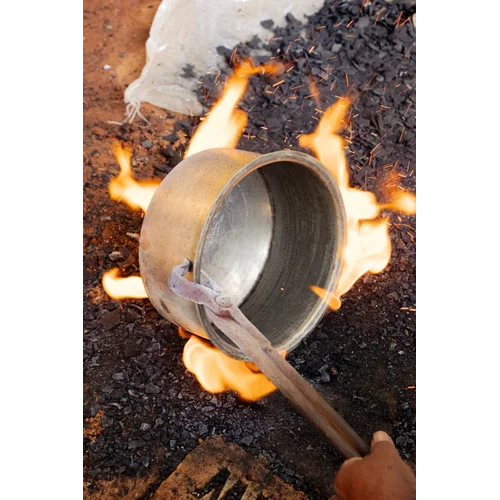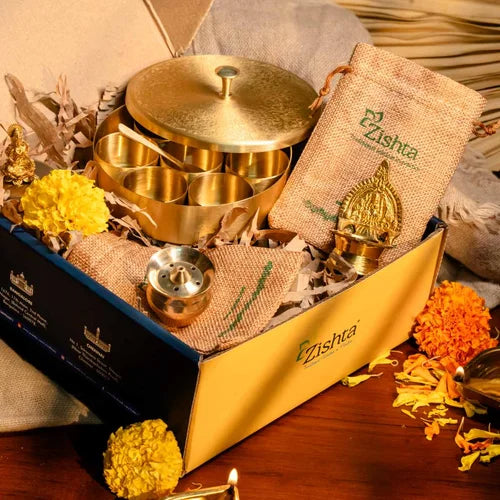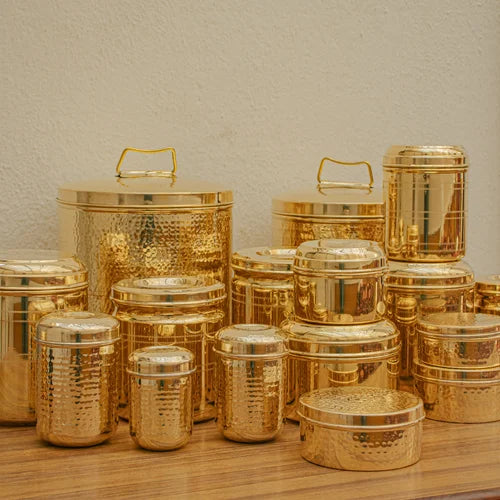In many Indian Kitchens, brass and copper vessels are not just utensils-they're an heirloom, a legacy off mindful, traditional living. These metals, revered for their health benefits and aesthetic charm, need a special process to make them safe for everyday cooking: Kalai, the age-old technique of lining.
Let’s explore the importance of kalai, how it’s traditionally done, precautions to prolong its life, and how you can even try it yourself at home.
Why Kalai is Essential for Brass and Copper Cookware
Brass and copper are reactive metals. When they come into contact with acidic foods (like tamarind, tomatoes, or lemon), they can leach into the food-leading to health risks over time. This is where Kalai (Kalhai) comes in.
What is Kalai
Kalai is a traditional tin-coating process where a thin layer of pure tin (and not lead) is applied inside the cookware. This not only makes the vessel food-safe but also adds to the longevity of the metal by preventing corrosion and reaction with food.

How Traditional Kalai is Done
The Kalai process is an intricate skill passed down generations of craftsmen:
- Cleaning and Heating: The vessel is thoroughly scrubbed and heated in an open fire until it reaches the right temperature.
- Applying Tin: A piece of pure tin is rubbed on the inner surface. The heat melts the tin, and the artisan quickly spreads it evenly with a cotton cloth or wooden spatula.
- Buffing: The vessel is immediately buffed while still hot to ensure the tin sticks properly, giving a silvery sheen to the inside.
This entire process is done manually, and timing is everything. If the vessel is overheated or the tin not applied correctly, coating won't last.

IMPORTANT: The tin used must be pure and food-grade-not mixed with lead, which can be toxic. Zishta ensures that all our Kalai kits and recommendations strictly use high-quality tin for safe home use.
How Often Should You Redo Kalai
The frequency depends upon usage patterns:
- For regular daily cooking, kalai may be needed to be redone every 6-9 months.
- For occasional use, it can last upto an year or more.
- A visible sign is when the inner silvery layer wears off, exposing the yellowish brass or reddish copper.
Precautions to Prolong the Life of Kalai
Taking care of your kalai-coated vessels can significantly extend their life:
- Avoid dry heating the vessel-always add oil or water before placing it on heat.
- Use wooden or silicone ladles to prevent scraping the inner layer.
- Wash with mild soap and a soft sponge-no abrasive powders or steel wool.
- Do not refrigerate food in kalai-coated vessels. The cold environment and prolonged moisture can deteriorate the tin layer faster.
Can You Do Kalai at Home
Yes, you can! While the traditional method is best done by skilled artisans, we understand many of you wish to preserve and maintain your cookware yourselves.
That’s why Zishta has created a DIY Kalai Kit along with a detailed video guide to help you perform kalai safely at home.
Watch the full tutorial here:
Zishta DIY Kalai Video
The video walks you through:
- The right tools and ingredients to use
- Precautions while working with heat and tin.
- Step-by-step instructions for a safe and effective tin coating.
Kalai is more than just a maintenance process-it’s a ritual of care and respect for the timeless materials in our kitchen. By understanding and preserving this craft, we keep alive a tradition that connects us to generations before us.
At Zishta, we are proud to offer not just the vessels, but the knowledge and tools to maintain them the traditional way. Whether you choose to get kalai done by a professional or try it yourself, doing it right ensures your cookware stay safe, functional and beautiful for years to come.




Leave a comment
All comments are moderated before being published.
This site is protected by hCaptcha and the hCaptcha Privacy Policy and Terms of Service apply.